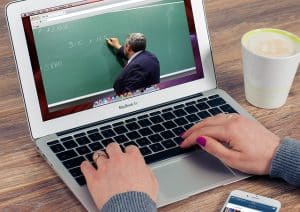E-learning is a new, important way of acquiring knowledge. It breaks classical classroom borders and is based on a more flexible, achievable, personalized education system. E-learning gives access to knowledge, be it in the form of texts, videos, or different modules, with the support of digital technology.
Suppose you are a working professional or a student in a small town. In that case, e-learning has made it possible for you to continue with your studies without having to walk into a classroom. In this blog, we will discuss what e-learning content creation is, how e-learning content is created, why it is essential, how it is made, and how it can be improved in the future.
What is E-Learning?

E-learning, popularly known as electronic learning, is a method of education in which the learner accesses online course content. This is generally done with the help of electronic gadgets like computers, tablets, or mobile phones.
E-learning integrates everything, even the small things of life that one can learn from a computer, such as cooking or learning a new language. The content includes audio, video, text, and quizzes so that users find learning more interesting. Unlike typical school environments, online learning fits students’ schedules and learning speed.
The Importance of E-Learning Content Creation

The increasing accessibility of education makes the creation of e-learning content important. It guarantees access to high-quality learning resources around the world. Well-designed E-learning content can be customized to fit different learning styles and speeds, and it promotes growth in education. This is very important in a society with various learning styles and demands.
E-learning materials can be easily expanded to reach thousands of students. It can also be quickly improved to include new information. It is a major benefit in industries like education and health, which are changing quickly. Good e-learning materials can help teachers by giving them the resources they need to improve their instruction and reach a larger student base.
Also Read: Why is Online Learning Better
How to Create Content for E-Learning?

Below are the steps you can follow for effective e-learning content creation:
Define the Audience
The first step in developing e-learning content is understanding who you create it for. You must consider the learners’ ages, previous knowledge, and areas that require teaching. This allows you to easily adjust your material according to their needs, ensuring it is appropriate for their difficulty level and covers relevant topics.
When you understand your audience’s needs, choosing the appropriate language, speed, and examples is easier. This way, you can guarantee that the students are neither overburdened nor bored.
Create Learning Goals
After identifying your target audience, you must set specific learning goals. First, you must ask yourself what students should be able to do after finishing your course. You should set clear objectives, such as, after this lesson, you will be able to solve basic algebra problems.
These goals help you to maintain the focus of your content. They provide your students with specific objectives, which can motivate and educate them.
Create the Course Design
The next stage is creating your course after deciding your audience and goals. It involves organizing your content in a logical and easy-to-find way.
You must choose which subjects to explore first, how to move from one to the next, and how to combine text, video, and some educational tasks.
Analyze the Learners
You must regularly analyze your students’ performance to ensure the effectiveness of your online course. This can be done through exercises, quick essays, or quizzes.
Both the student and the teacher should receive feedback from these assessments. It can contain details about the sections of the course that are effective and those that might need revision. A thorough review guarantees that learning objectives are being reached and helps improve content.
Trends in E-Learning Content Creation

The trends that should be incorporated into the e-learning content development process are as follows:
Interactive Learning
Learning becomes more interesting when it is interactive. Students can actively participate instead of only reading or watching, using resources like LMS content development, quiz activities, and simulations.
It can improve the enjoyment and retention of learning. Additionally, it pushes students to exercise critical thinking and apply what they’ve learned to real-life scenarios.
Artificial Intelligence
The acceptance of artificial intelligence (AI) in e-learning is increasing. AI can help customize learning experiences to each learner’s needs. It provides options for content that consider the learners’ preferences and speed.
Additionally, it can give real-time feedback, which helps students quickly understand their mistakes. AI is bringing intelligence and adaptability to e-learning.
Micro-Learning
Microlearning is dividing knowledge into manageable, quickly remembered little portions.
Nowadays, finding the time for long research sessions might be challenging, so this trend is really helpful. Micro-learning allows you to study for short periods anytime you have free minutes.
Mobile Learning
You can access educational resources on your mobile device and learn at any time or place through mobile learning.
The trend is beneficial for people who are constantly on the move. You can turn your tablet or smartphone into a portable classroom with mobile learning.
Authoring Tools
The software used for developing e-learning content is called an authoring tool. You don’t need to be a computer expert to design successful learning modules because they come with pre-made templates and user-friendly interfaces.
Anyone can create educational content with a professional appearance more quickly and easily with the help of these tools.
Also Read: Bespoke eLearning
Final Thoughts
Creating content for e-learning involves so much more than just putting data online. It’s about ensuring that education is practical, approachable, and fun for everybody. Teachers can create engaging and inclusive learning environments by adopting modern developments and technology.
E-learning is said to have a bright future as long as technology keeps developing. It offers countless opportunities to improve teaching and learning. Instructors and course creators need to continue being creative and attentive to the needs of students. They have to ensure this digital educational revolution is open to everybody.






